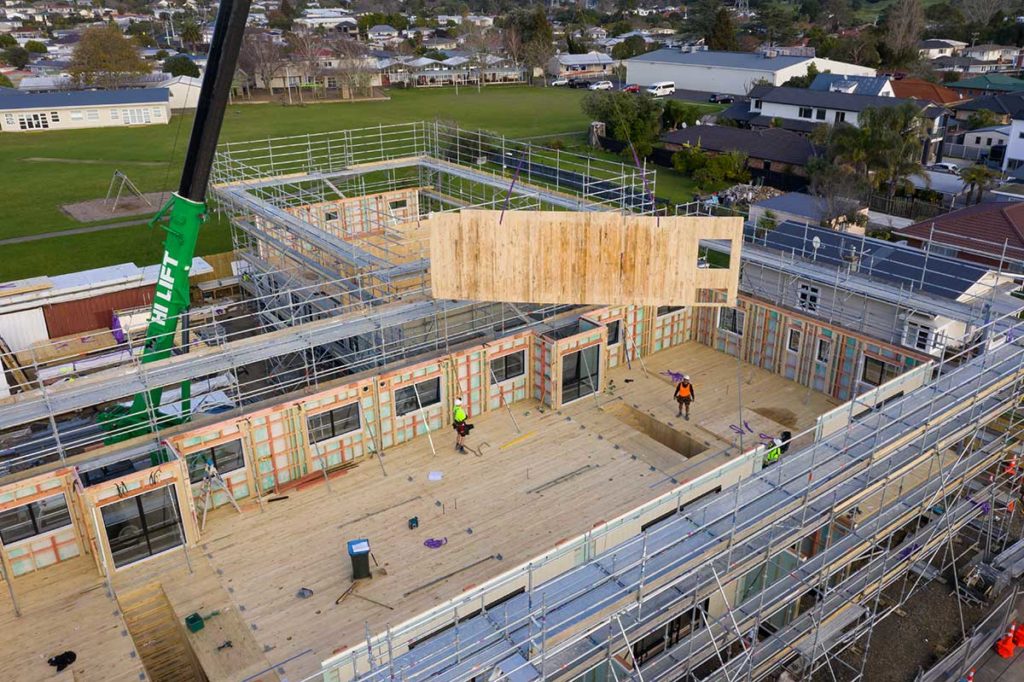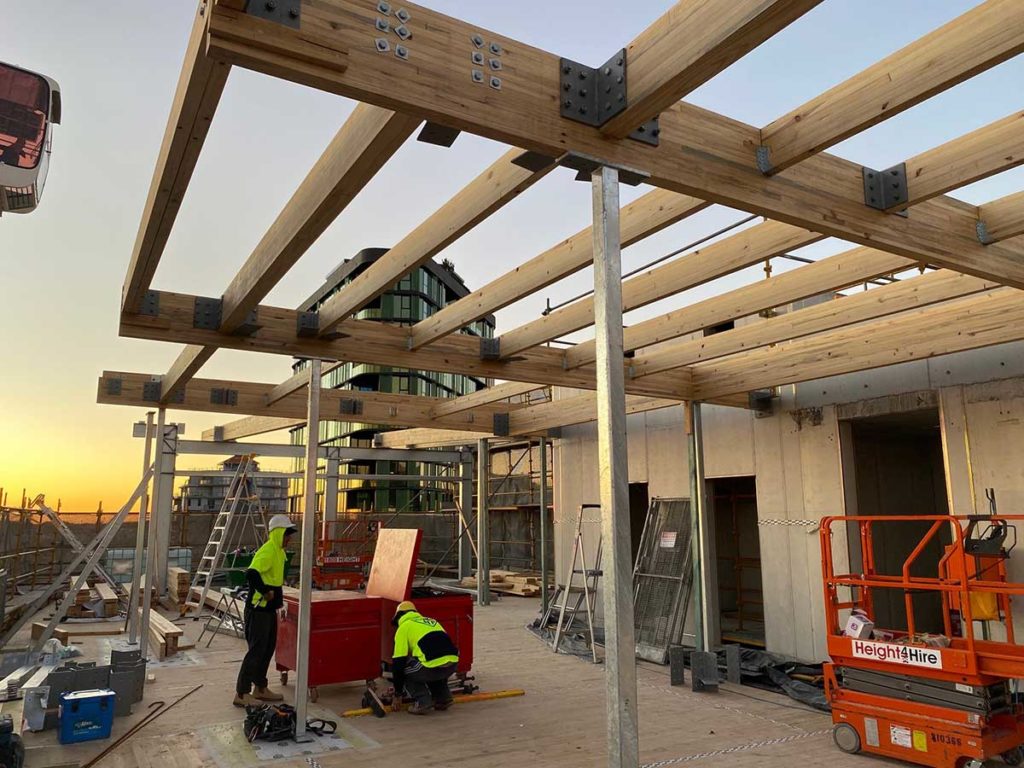CLT panel & GLT post & beam- Ceres Farmhouse1
Timber has been used in construction since man first ventured beyond the cave, however
recent advances in engineered timber products have resulted in mass timber construction (MTC) becoming considered as a commercially viable alternative to concrete and steel.
Whist concrete construction contributed to the expansion of the Roman Empire, and the Industrial revolution developed steel that allowed skyscrapers to become a reality, MTC is poised to become the revolutionary new building technology for the 21st Century.
Capable of being produced as large sheets or very long spans, MTC products using sustainable plantation grown hardwood and softwood timbers are providing Architects with exciting new design opportunities.
No longer restricted primarily to domestic construction, highrise and commercial buildings are now being built throughout the world using MTC.

GLT Beams – Cork Memorial Medical Centre – Dorrigo²
MTC PRODUCTS
MTC consists of a range of different engineered structural products commonly known by their respective acronyms including;
- GLT – Glue laminated timber – consists of multiple horizontal timber pieces or laminates glued and compressed into high strength straight or curved beams.
- LVL – Laminated veneer lumber – manufactured by bonding together rotary sliced vertical thin veneers under heat and pressure to create straight beams or I joists.

LVL Example
- CLT – Cross laminated timber – similar to plywood but consists of thicker layers of structural grade timber boards stacked in alternative perpendicular layers and glued together under high pressure to create structural sheets of varying sizes and thicknesses.

CLT Example
Both GLT and LVL products have been used for decades, however CLT is the real construction disrupter, offering numerous benefits over conventional construction materials and techniques.
THE BENEFITS OF CLT
As the numerous benefits of CLT become evident to the construction Industry, the product is likely to be widely embraced and reduce our reliance on older unsustainable construction technologies.
Sustainability
CLT is a new clean and green construction material alternative.
Concrete requires an exorbitant amount of clean sand which is rapidly depleting and destroying ancient riverbeds globally.
Steel is produced from another finite resource and requires an enormous amount of energy to produce.
In contrast, timber is a renewable commodity that can be continually regenerated through chain of custody certified plantations. It also locks carbon within its fabric. Every cubic metre of radiata pine timber sequesters 612kg of CO2, whilst the same volume of concrete expresses 410kg of CO2 into the atmosphere.

CLT panel & prefabricated preclad exterior wall panel hybrid construction Busby Street Social Housing, Auckland – NZ3
Prefabrication
CLT panels are designed for ease of both manufacture and assembly.
Factory production, cutting and shaping to size eliminates on-site waste.
Quicker installation can result in a 25 – 30% reduction in site time with resultant cost savings.
Manufacturing in a controlled factory environment also ensures high standards of quality.
Simpler Construction
Timber in comparison with other materials is an easy material to work with, offering greater flexibility in its ease of cutting and drilling.
Being much lighter than steel, masonry and concrete products, it is easier, quicker, cleaner, quieter and safer to install, requiring significantly less labour.
Its light weight also reduces the load placed on footings, allowing for smaller and cheaper building foundations. This can result in a 30% saving in material, time and cost of the foundations due to MTC being 20-25% the mass of the equivalent concrete construciton.
Stability
MTC products are manufactured from kiln dried timber which increases the stability of the base veneers.
GLT and LVL join timber veneers together with the grains all aligning in a longitudinal direction.
CLT however laminates layers in both longitudinal and transverse directions which significantly reduces the ability of the timber boards to expand and contract, making them extremely stable in a wide range of environmental conditions.

GLT columns – high strength & good fire resistance4
Strength
Compared with steel, LVL’s strength to weight ratio is 20% greater, whilst CLT has the same strength as reinforced concrete at just a fraction of the weight.
CLT panels perform well as loadbearing walls or columns eliminating the need for additional structure, and used in conjunction with GLT and LVL beams, can achieve large spans as floor or roof elements.
Durability
The timber and glues selected for manufacturing CLT determine the ultimate durability of the product for different applications. CLT panels typically perform better than many other materials in corrosive high humidity environments, however care needs to be taken with the choice of metal fixing components.
Additives and applied coatings also significantly improve the durability of CLT.
Fire
Timber is a combustible material, however with sufficient mass, it can perform better than many other non-combustible materials when exposed to fire.
As timber burns it forms a self-insulating charred outer layer that slows the combustion process maintaining its inner structural strength and integrity for longer.
Typically, CLT panels can achieve a 2 hour fire rating, however it’s the steel connections used to fix the panels that typically become the points of failure.
CLT’s cross sectional thickness and almost airtight manufacture reduces the fires ability to spread, and its thermal mass prevents heat conduction between one side of the panel to the other.
CLT doesn’t spall and break apart or deform in fire conditions like unprotected concrete and steel products are prone to do.
Seismic performance.
CLT is a stronger version of plywood which is commonly used to structurally brace walls.
The cross-lamination process used to manufacture CLT panels creates very strong shear diaphragms that are highly resistant to seismic loads.

Relaxing environment utilising CLT floor, walls and ceiling5
Biophilia
Timber is a familiar natural product that we use for a myriad of applications in our daily lives.
Biophilia is defined as a love of life and the living world and describes humanity’s innate tendency to seek connections with nature and other forms of life. (For more information on biophilia you can read our articlehttps://themedicallink.com.au/home/2018/11/20/vertical-gardens-the-ultimate-in-organic-architecture)
WELL is the leading tool for advancing health and wellbeing in buildings globally and uses an evidence-based system that assesses seven categories – air, water, nourishment, light, fitness, comfort and mind.
CLT buildings have the potential to achieve very high WELL ratings due to the biophilia impact.
Insulation
The high thermal mass of CLT makes it a particularly good insulator, minimising the need for additional insulation and reducing heating and cooling costs.
CLT panels also achieve exceptional acoustic insulation reducing both airborne and impact sound transmission.
THE NEGATIVES
As with any new technology, there are bound to be some limitations to its application, its ultimate success will rely on the positives outweighing the negatives.
As the technology continues to develop, many of these negatives are likely to be addressed and satisfactorily resolved.
Acceptance
Regrettably, the building industry has always been averse to changing the status quo to adopt new building materials and construction technologies.
It requires brave developers and progressive Architects and Engineers to be the pioneers and extol the many virtues of CLT construction.
This may be offset to some degree by the fact that timber is already a commonly used building material, so tradesmen already have many of the necessary skills to work with CLT.
Cost
This is largely related to acceptance. The cost of manufacturing CLT is driven by demand. There is considerable capital expenditure required to establish a CLT manufacturing plant, and until a few years ago, CLT products had to be imported from overseas.
Fortunately we now have a few Australian manufacturers capable of producing the product, the major supplier on the east coast being Xlam in Wodonga – https://www.xlam.co.nz/

XLam CLT manufacturing facility6
This initial lack of competition potentially increases CLT supply costs, and the interstate manufacturing location does incur additional transportation costs for use in locations like Queensland. However, given the previous alternative was international shipping, these additional costs are considered marginal in relation to the other long term financial benefits of using the product.
Fire
The International Building Code (IBC) has been reluctant to recognize CLT as a structural material believing there has not been enough testing to determine how CLT performs in varying fire conditions.
This has resulted in a limitation to the maximum number of storeys allowed in CLT-constructed buildings without incorporating significant additional fire protection systems. These upgrades ultimately have a considerable impact on cost.
Whilst the IBC currently proposes limiting the height of timber buildings to 18 storeys, Australia’s National Construction Code (NCC) only allows a maximum height of 8 storeys (25m) unless alternative fire engineering concessions are granted.
This initial trepidation is likely to result in increased insurance premiums until the product gains wider acceptance as a safe construction system capable of achieving higher fire ratings.
Health Issues
CLT requires glues to bind the laminates together, some of which have been found to emit toxic VOC gases including formaldehyde.
This was highlighted after a 2016 health scare in China when CLT products – mainly composite timber flooring – were found to contain extremely high levels of formaldehyde which resulted in tens of thousands of consumers replacing their CLT floorboards.
This is unlikely to be an issue with Australian manufactured CLT, and given the heightened awareness of the quality issues surrounding imported foreign manufactured materials, regulations are likely to ensure it is no longer a threat in the future.
Weathering
Laminated timbers are generally not recommended for use externally where they are likely to be exposed to the weathering impacts of both sun and rain.
Consequently external CLT panels need to be covered with a weatherproof cladding.
In high humidity environments, the impact of moisture on the glues used in manufacturing CLT is still largely unknown, as is the potential for mould growth. This is currently being researched, and no doubt should problems be identified, solutions will be applied.
Damage
Many CLT products are produced from softwood timbers, and as such are prone to be easily damaged if left unprotected.
This is particularly the case with CLT stairs where it is recommended to line the treads and nosings with impact resistant materials.
Polyurethane coatings also provide a reasonable level of protection.

GLT beams & CLT floors & walls – 10 Storey Apartment building7
RECENT APPLICATIONS
The versatility of CLT products allows them to be applied to a wide range of applications for building structural elements including columns, floors, walls, roofs and stairs.
Brisbane currently boasts the tallest CLT building in Australia, Lend Lease’s 10 storey office tower at 25 King Street completed in 2018. This time lapse video shows its construction – https://vimeo.com/295714193
Monterey Apartments, another 10 storey building constructed using CLT at Kangaroo Point is also nearing completion. https://montereykangaroopoint.com.au/construction/
Adelaide’s newest Hotel, the boutique Oval is also constructed from CLT and is due for completion in the near future.

CLT prefabricated panels being installed – Oval Hotel8
Undoubtedly the most ambitious highrise timber construction building ever proposed is Atlassian’s recently announced Sydney headquarters.
At 40 stories high, the tech giant’s head office will be the tallest hybrid timber structure in the world. It’s also targeting a substantial 50% reduction in embodied carbon and energy compared to conventional construction – see World’s tallest hybrid timber tower to be build.
Still unsure about the benefits of timber construction? This TED talk may help you decide.
If you’d like to explore the use of CLT on your next project or would like more information, contact us.
Thanks to Robert Mansell and John Eastwood from XLam for supplying some of the information and images used in this article.
Design and photo credits.
- Ceres Farmhouse – Nadine Samaha, Level Architekture Konstrukt, Image courtesy XLam.
- Busby Street Social Housing, NZ – Bernie O’Fagan – RM Designs – Image courtesy XLam.
- Cork Memorial Medical Centre – Dorrigo – Dan Stevens – RegionalArchitects – Image courtesy XLam
- Monterey Building- Brisbane by Gardner Vaughan Group (GVG)- Image courtesy XLam
- Private Residence – Image courtesy XLam
- CLT manufacturing plant – Image courtesy XLam
- Monterey Apartments Kangaroo Point by Gardner Vaughan- Image courtesy XLam
- Adelaide Oval Hotel – Image courtesy XLam
You might also be interested in...

Refurbish or Demolish?
Whilst most of our projects involve designing new buildings, we are also regularly undertake renovations of existing properties.

A Guide to Working with an Architect for your Home Design
Designing your new home can be an exciting time. Conversely, it may also be daunting with many important considerations to take into account.










